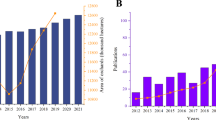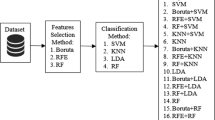Abstract
This paper addresses the issue of automatic wood defect classification. A tree-structure support vector machine (SVM) is proposed to classify four types of wood knots by using images captured from lumber boards. Simple and effective features are proposed and extracted by partitioning the knot images into three distinct areas, followed by utilizing a novel order statistic filter to yield an average pseudo color feature in each area. Excellent results have been obtained for the proposed SVM classifier that is trained by 800 wood knot images. Performance evaluation has shown that the proposed SVM classifier resulted in an average classification rate of 96.5% and false alarm rate of 2.25% over 400 test knot images. Future work will include more extensive tests on large data set and the extension of knot types.






Similar content being viewed by others
References
Andersson H (2008) Automatic classification of wood defects using support vector machines. MSc thesis, Chalmers University of Technology, Sweden
Chacon IM, Alonso GR (2006) Wood defects classification using a SOM/FFP approach with minimum dimension feature vector, LNCS 3973: 1105–1110 (3rd Int’l symp. on neural networks, Chengdu, China)
Estevez PA, Perez CA, Goles E (2003) Genetic input selection to a neural classifier for defect classification of radiata pine boards. For Prod J 53(7):87–94
FSS (Föoreningen Svenska Sägverksmän) (1999) Nordiskt trä: sorteringsreglar (Nordic trees: rules for sorting). Markaryds Grafiska (ISBN: 91-7322-251-8)
Grönlund U (1995) Quality improvements in forest products industry. Dissertation. Luleå University of Technology, Sweden
Hsu CW, Chang CC, Lin CJ (2007) A practical guide to support vector classification. http://www.csie.ntu.edu.tw/~cjlin/papers/guide/guide.pdf. Accessed May 2009
Huber HA, McMillin CW, McKinney JP (1985) Lumber defect detection abilities of furniture rough mill employees. For Prod J 35:79–82
Kauppinen H, Silven O (1996) The effect of illumination variations on color-based wood defect classification. Proceedings of IEEE international conference. ICPR:828–832
Ma J, Zhao Y, Ahalt S, Eads D (2003) Matlab SVM toolbox from OSU. http://svm.sourceforge.net/docs/3.00/api/. Accessed May 2009
Schölkopf B, Smola AJ (2002) Learning with kernels—support vector machines, regularization, optimization and beyond. MIT Press, Cambridge
Shawe-Taylor J, Cristianini N (2000) An introduction to support vector machines and other kernel-based learning methods. Cambridge University Press, New York
Silven O (2009) The database for Finnish sound wood knots. http://www.ee.oulu.fi/research/imag/knots/KNOTS/. Accessed May 2009
Silven O, Kauppinen H (1996) Recent development in wood inspection. Intern J Pattern Recognit Artif Intell 19(1):83–95
Silven O, Niskanen M, Kauppinen H (2003) Wood inspection with non-supervised clustering. Mach Vis Appl 13(5–6):275–285
Acknowledgment
The Swedish wood images were kindly provided by Rosens Maskin AB, Sweden.
Author information
Authors and Affiliations
Corresponding author
Rights and permissions
About this article
Cite this article
Gu, I.YH., Andersson, H. & Vicen, R. Wood defect classification based on image analysis and support vector machines. Wood Sci Technol 44, 693–704 (2010). https://doi.org/10.1007/s00226-009-0287-9
Received:
Published:
Issue Date:
DOI: https://doi.org/10.1007/s00226-009-0287-9




